|
 |
 Автор: Williams Автор: Williams
 Дата: 14 июля 2019 Дата: 14 июля 2019
 Просмотров: 981 Просмотров: 981 |
| |
Neil W. Polhemus - Process Capability Analysis: Estimating Quality
+ docs & webinars
CRC Press, 2018
pdf, 285 pages, english
ISBN: 978-1-138-03015-2
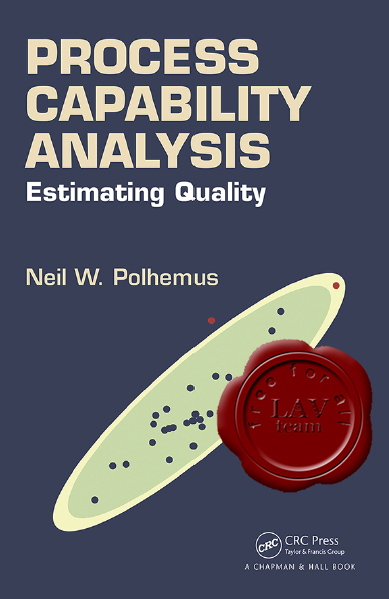
Process Capability Analysis: Estimating Quality presents a systematic exploration of process capability analysis and how it may be used to estimate quality. The book is designed for practitioners who are tasked with insuring a high level of quality for the products and services offered by their organizations. Along with describing the necessary statistical theory, the book illustrates the practical application of the techniques to data that do not always satisfy the standard assumptions. The first two chapters deal with attribute data, where the estimation of quality is restricted to counts of nonconformities. Both classical and Bayesian methods are discussed. The rest of the book deals with variable data, including extensive discussions of both capability indices and statistical tolerance limits. Considerable emphasis is placed on methods for handling non-normal data. Also included are discussions of topics often omitted in discussions of process capability, including multivariate capability indices, multivariate tolerance limits, and capability control charts. A separate chapter deals with the problem of determining adequate sample sizes for estimating process capability. |
| |
 Читать статью дальше (комментариев - 8)
Читать статью дальше (комментариев - 8)
| |
|
 |
 Автор: Williams Автор: Williams
 Дата: 7 июля 2018 Дата: 7 июля 2018
 Просмотров: 2 122 Просмотров: 2 122 |
| |
Donald W. Knight, Caroline Hazlewood, Rob Lamb, Paul G. Samuels, Koji Shiono -
Practical Channel Hydraulics: Roughness, Conveyance and Afflux
2nd Edition
CRC Press, 2018
pdf, 634 pages, english
ISBN: 978-1-138-06858-2 (Hbk)
ISBN: 978-1-315-15777-1 (eBook)
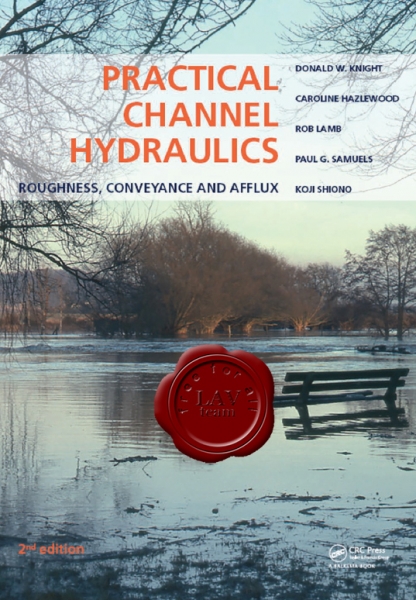 Practical Channel Hydraulics is a technical guide for estimating flood water levels in rivers using the innovative software known as the Conveyance and Afflux Estimation System (CES-AES). The stand alone software is freely available at HR Wallingford’s website www.river-conveyance.net. The conveyance engine has also been embedded within industry standard river modelling software such as InfoWorks RS and Flood Modeller Pro. This 2nd Edition has been greatly expanded through the addition of Chapters 6-8, which now supply the background to the Shiono and Knight Method (SKM), upon which the CES-AES is largely based.
With the need to estimate river levels more accurately, computational methods are now frequently embedded in flood risk management procedures, as for example in ISO 18320 (‘Determination of the stage-discharge relationship’), in which both the SKM and CES feature. The CES-AES incorporates five main components: A Roughness Adviser, A Conveyance Generator, an Uncertainty Estimator, a Backwater Module and an Afflux Estimator. The SKM provides an alternative approach, solving the governing equation analytically or numerically using Excel, or with the short FORTRAN program provided.
Special attention is paid to calculating the distributions of boundary shear stress distributions in channels of different shape, and to appropriate formulations for resistance and drag forces, including those on trees in floodplains. Worked examples are given for flows in a wide range of channel types (size, shape, cover, sinuosity), ranging from small scale laboratory flumes (Q = 2.0 1s-1) to European rivers (~2,000 m3s-1), and large-scale world rivers (> 23,000 m3s-1), a ~ 107 range in discharge. Sites from rivers in the UK, France, China, New Zealand and Ecuador are considered.
Topics are introduced initially at a simplified level, and get progressively more complex in later chapters. This book is intended for post graduate level students and practising engineers or hydrologists engaged in flood risk management, as well as those who may simply just wish to learn more about modelling flows in rivers. |
| |
 Читать статью дальше (комментариев - 12)
Читать статью дальше (комментариев - 12)
| |
|
 |
 Автор: Williams Автор: Williams
 Дата: 23 марта 2018 Дата: 23 марта 2018
 Просмотров: 2 525 Просмотров: 2 525 |
| |
Pinliang Dong, Qi Chen - LiDAR Remote Sensing and Applications
CRC, 2018
pdf, 221 pages, english
ISBN: 978-1-4822-4301-7
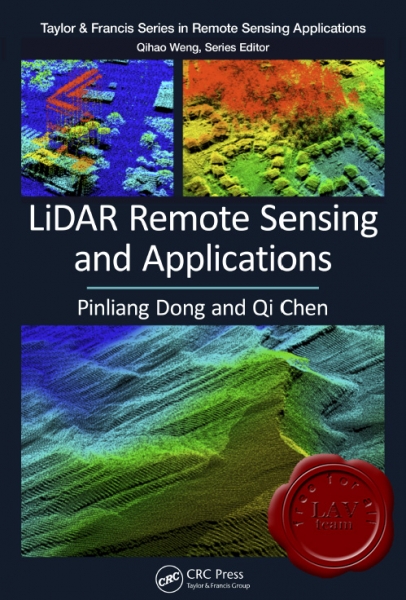
This is a unique book in that it smoothly combines LiDAR principles, data processing methods, applications, and hands-on practices, following an overview of remote sensing. An index map of LiDAR data and a list of abbreviations are also included to improve the readability of the book. For forest applications, readers can find examples such as creating leaf-on and leaf-off canopy height models in Susquehanna Shale Hills, PA; identifying disturbances from lightning and hurricane in mangrove forests in Florida; and estimating aboveground biomass in tropical forests in Ghana. For urban applications, readers can see examples such as road extraction, powerline corridor mapping, and population estimation in Denton, TX; parcel-based building change detection in Surrey, Canada; and road blockage detection in Port-au-Prince after the 2010 Haiti earthquake. For geoscience applications, readers can explore samples such as measuring dune migration rates in White Sands, NM; analysis of offset channels associated with the San Andreas Fault in California; and trend surface analysis and visualization of rock layers in Raplee Ridge, UT. Undergraduate and graduate students will find that the 11 step-by-step GIS projects with LiDAR data can really help them understand LiDAR data processing, analysis, and applications, while professionals and researchers will benefit from various topics on LiDAR remote sensing and applications, along with over 500 references in the book. |
| |
 Читать статью дальше (комментариев - 22)
Читать статью дальше (комментариев - 22)
| |
|
 |
 Автор: Williams Автор: Williams
 Дата: 6 июля 2017 Дата: 6 июля 2017
 Просмотров: 2 713 Просмотров: 2 713 |
| |
Nayef Ghasem - Computer Methods in Chemical Engineering
CRC, 2011
pdf, 513 pages, english
ISBN 9781439849996
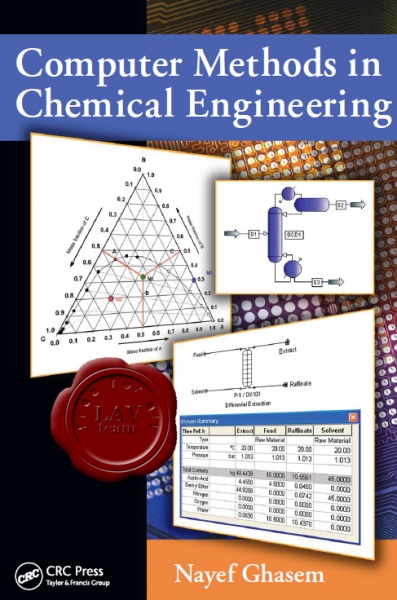
In industry, complicated problems are often not solved by hand for two reasons: human error and time constraints. There are many different simulation programs used in industry, depending on field, application, and desired simulation products. When software is used to its full capabilities, it is a very powerful tool for a chemical engineer in a variety of fields, including oil and gas production, refining, chemical and petrochemical processes, environmental studies, and power generation. Although most of the software packages are user friendly, considerable effort must be expended to master these softwares.
Software packages, such as PRO/II, Hysys/Unisim, Aspen Plus, and Design Pro, have been developed to perform rigorous solutions of most unit operations in chemical engineering. However, as a design engineer, one always needs to know the fundamental theory and methods of calculation to enable one to make decisions about the validity of these black box packages to verify the results. Most software packages are interactive process simulation programs. They are user-friendly and powerful programs that can be used to solve various kinds of chemical engineering processes. However, various conditions and choices have to be provided in order to solve a problem; good knowledge about the process is needed to be used effectively. The objective of this book is to introduce chemical engineering students to the most commonly used simulation softwares and the theory in order to cover core chemical engineering courses. The book is very useful in covering the application parts in various core chemical engineering courses such as chemical engineering thermodynamics, fluid mechanics, material and energy balances, mass transfer operations, reactor design, computer applications in chemical engineering, and also in graduation projects and in industrial applications.
Each chapter in Computer Methods in Chemical Engineering contains a theoretical description of process units followed by numerous examples solved by hand calculations and simulation with the four software packages, Hysys/Unisim, PRO/II, Aspen Plus, and SuperPro Designer, through step-by-step instructions. The book is perfect for students and professionals and gives them the tools to solve real problems involving mainly thermodynamics and fluid phase equilibria, fluid flow, material and energy balances, heat exchangers, reactor design, distillation, absorption, and liquid–liquid extraction. |
| |
 Читать статью дальше (комментариев - 15)
Читать статью дальше (комментариев - 15)
| |
|
 |
 Автор: Williams Автор: Williams
 Дата: 15 января 2015 Дата: 15 января 2015
 Просмотров: 1 154 Просмотров: 1 154 |
| |
Alexander H.D. Cheng -
Multilayered Aquifier Systems: Fundamentals and Applications
(Civil and Environmental Engineering, Book 3)
CRC Press; 2000
pdf, 399 pages, english
ISBN-10: 0824798759
ISBN-13: 978-0824798758
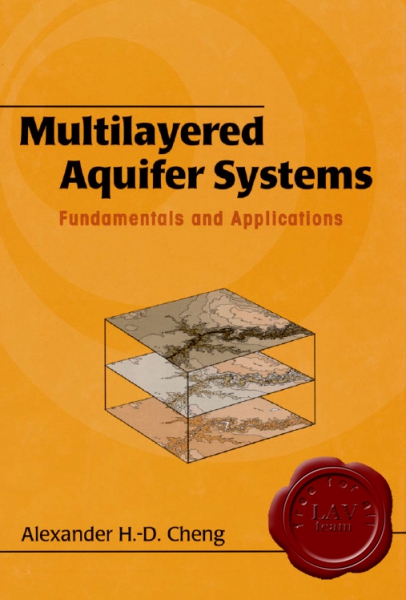
Offers a systematic and unified approach to the classical theories and recent techniques of multilayered aquifer systems. Clarifies governing principles and facilitates industrial problem solving. Uses the automated numerical Laplace inversion procedure to simplify mathematical materials. |
| |
 Читать статью дальше (комментариев - 11)
Читать статью дальше (комментариев - 11)
| |
|
 |
 Автор: Williams Автор: Williams
 Дата: 13 июля 2014 Дата: 13 июля 2014
 Просмотров: 3 280 Просмотров: 3 280 |
| |
Saeid Eslamian - Handbook of Engineering Hydrology:
Fundamentals and Applications; Modeling, Climate Change and Variability; Environmental Hydrologiy and Water
CRC Press, 2014
pdf, 624+634+594 pages, english
ISBN 9781466552418, 9781466552463, 9781466552494
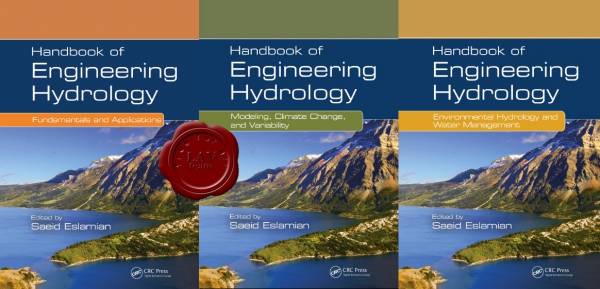
While most books examine only the classical aspects of hydrology, this three-volume set covers multiple aspects of hydrology, and includes contributions from experts from more than 30 countries. It examines new approaches, addresses growing concerns about hydrological and ecological connectivity, and considers the worldwide impact of climate change. It also provides updated material on hydrological science and engineering, discussing recent developments as well as classic approaches. Published in three books, Fundamentals and Applications; Modeling, Climate Change, and Variability; and Environmental Hydrology and Water Management, the entire set consists of 87 chapters, and contains 29 chapters in each book.
The chapters in this book contain information on:
- the anthropocenic aquifer, groundwater vulnerability, and hydraulic fracturing, and environmental problems;
- disinfection of water, environmental engineering for water and sanitation systems, environmental nanotechnology, modeling of wetland systems, nonpoint source and water quality modeling, water pollution control using low-cost natural wastes, and water supply and public health and safety;
- environmental flows, river managed system for flood defense, stormwater modeling and management, tourism and river hydrology, and transboundary river basin management;
- the historical development of wastewater management, sediment pollution, and sustainable wastewater treatment;
- water governance, scarcity, and security;
- the formation of ecological risk on plain reservoirs, modification in hydrological cycle, sustainable development in integrated water resources management, transboundary water resource management, and more.
|
| |
 Читать статью дальше (комментариев - 16)
Читать статью дальше (комментариев - 16)
| |
|
 |
 Автор: Williams Автор: Williams
 Дата: 23 июня 2014 Дата: 23 июня 2014
 Просмотров: 3 055 Просмотров: 3 055 |
| |
Wai-Fah Chen, Lian Duan - Bridge Engineering Handbook, Second Edition:
Fundamentals, Superstructure, Substructure, Seismic Design, Construction and Maintenance
CRC Press, 2014
pdf, 614+734+378+722+644 pages, english
ISBN 9781439852071, 9781439852217, 9781439852194, 9781439852187, 9781439852088
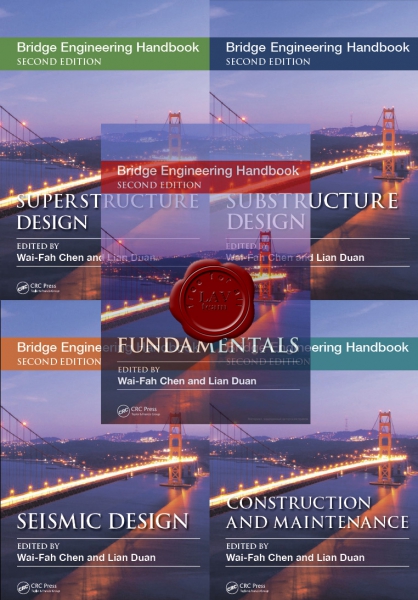
Over 140 experts, 14 countries, and 89 chapters are represented in the second edition of the Bridge Engineering Handbook. This extensive collection highlights bridge engineering specimens from around the world, contains detailed information on bridge engineering, and thoroughly explains the concepts and practical applications surrounding the subject.
Published in five books: Fundamentals, Superstructure Design, Substructure Design, Seismic Design, and Construction and Maintenance, this new edition provides numerous worked-out examples that give readers step-by-step design procedures, includes contributions by leading experts from around the world in their respective areas of bridge engineering, contains 26 completely new chapters, and updates most other chapters. It offers design concepts, specifications, and practice, as well as the various types of bridges. The text includes over 2,500 tables, charts, illustrations, and photos. The book covers new, innovative and traditional methods and practices; explores rehabilitation, retrofit, and maintenance; and examines seismic design and building materials.
The first book, Fundamentals contains 22 chapters, and covers aesthetics, planning, design specifications, structural modeling, fatigue and fracture.
The second book, Superstructure Design, contains 19 chapters, and covers information on how to design all types of bridges.
The third book, Substructure Design, contains 11 chapters addressing the various substructure components.
The fourth book, Seismic Design contains 18 chapters, and covers seismic bridge analysis and design.
The fifth book, Construction and Maintenance contains 19 chapters, and covers the practical issues of bridge structures.
What’s New in the Second Edition:
- Includes two new chapters: Extradosed Bridges and Stress Ribbon Pedestrian Bridges.
- Updates the Prestressed Concrete Girder Bridges chapter and rewrites it as two chapters: Precast/Pretensioned Concrete Girder Bridges and Cast-In-Place Post-Tensioned Prestressed Concrete Girder Bridges.
- Expands the chapter on Bridge Decks and Approach Slabs and divides it into two chapters: Concrete Decks and Approach Slabs.
- Rewrites seven chapters: Segmental Concrete Bridges, Composite Steel I-Girder Bridges, Composite Steel Box Girder Bridges, Arch Bridges, Cable-Stayed Bridges, Orthotropic Steel Decks, and Railings.
This text is an ideal reference for practicing bridge engineers and consultants (design, construction, maintenance), and can also be used as a reference for students in bridge engineering courses. |
| |
 Читать статью дальше (комментариев - 8)
Читать статью дальше (комментариев - 8)
| |
|
 |
 Автор: Williams Автор: Williams
 Дата: 15 июня 2014 Дата: 15 июня 2014
 Просмотров: 1 961 Просмотров: 1 961 |
| |
Wai-Fah Chen, Lian Duan - Bridge Engineering Handbook, Second Edition:
Superstructure, Substructure, Seismic Design, Construction and Maintenance
CRC Press, 2014
pdf, 734+378+722+644 pages, english
ISBN 9781439852217, 9781439852194, 9781439852187, 9781439852088
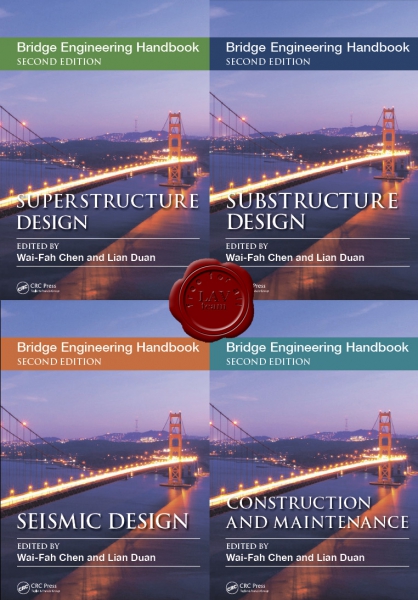
Over 140 experts, 14 countries, and 89 chapters are represented in the second edition of the Bridge Engineering Handbook. This extensive collection highlights bridge engineering specimens from around the world, contains detailed information on bridge engineering, and thoroughly explains the concepts and practical applications surrounding the subject.
Published in five books: Fundamentals, Superstructure Design, Substructure Design, Seismic Design, and Construction and Maintenance, this new edition provides numerous worked-out examples that give readers step-by-step design procedures, includes contributions by leading experts from around the world in their respective areas of bridge engineering, contains 26 completely new chapters, and updates most other chapters. It offers design concepts, specifications, and practice, as well as the various types of bridges. The text includes over 2,500 tables, charts, illustrations, and photos. The book covers new, innovative and traditional methods and practices; explores rehabilitation, retrofit, and maintenance; and examines seismic design and building materials.
The first book (is still absent), Fundamentals contains 22 chapters, and covers aesthetics, planning, design specifications, structural modeling, fatigue and fracture.
The second book, Superstructure Design, contains 19 chapters, and covers information on how to design all types of bridges.
The third book, Substructure Design, contains 11 chapters addressing the various substructure components.
The fourth book, Seismic Design contains 18 chapters, and covers seismic bridge analysis and design.
The fifth book, Construction and Maintenance contains 19 chapters, and covers the practical issues of bridge structures.
What’s New in the Second Edition:
- Includes two new chapters: Extradosed Bridges and Stress Ribbon Pedestrian Bridges.
- Updates the Prestressed Concrete Girder Bridges chapter and rewrites it as two chapters: Precast/Pretensioned Concrete Girder Bridges and Cast-In-Place Post-Tensioned Prestressed Concrete Girder Bridges.
- Expands the chapter on Bridge Decks and Approach Slabs and divides it into two chapters: Concrete Decks and Approach Slabs.
- Rewrites seven chapters: Segmental Concrete Bridges, Composite Steel I-Girder Bridges, Composite Steel Box Girder Bridges, Arch Bridges, Cable-Stayed Bridges, Orthotropic Steel Decks, and Railings.
This text is an ideal reference for practicing bridge engineers and consultants (design, construction, maintenance), and can also be used as a reference for students in bridge engineering courses. |
| |
 Читать статью дальше (комментариев - 15)
Читать статью дальше (комментариев - 15)
| |
|
 |
| ПОИСК ПО САЙТУ |
 |
|
 |
| КАЛЕНДАРЬ | | |
 |
| « Сентябрь 2025 » |
|---|
| Пн | Вт | Ср | Чт | Пт | Сб | Вс |
|---|
| 1 | 2 | 3 | 4 | 5 | 6 | 7 | | 8 | 9 | 10 | 11 | 12 | 13 | 14 | | 15 | 16 | 17 | 18 | 19 | 20 | 21 | | 22 | 23 | 24 | 25 | 26 | 27 | 28 | | 29 | 30 | |
|
 | |
| |
|